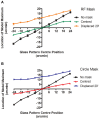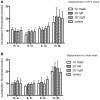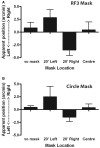Detecting global form: separate processes required for Glass and radial frequency patterns
- PMID: 23658542
- PMCID: PMC3647114
- DOI: 10.3389/fncom.2013.00053
Detecting global form: separate processes required for Glass and radial frequency patterns
Abstract
Global processing of form information has been studied extensively using both Glass and radial frequency (RF) patterns. Models, with common early stages, have been proposed for the detection of properties of both pattern types but human performance has not been examined to determine whether the two pattern types interact in the manner this would suggest. The experiments here investigated whether low RF patterns and concentric Glass patterns, which are thought to tap the same level of processing in form-vision, are detected by a common mechanism. Six observers participated in two series of masking experiments. First: sensitivity to the presence of either coherent structure, or contour deformation, was assessed. The computational model predicted that detection of one pattern would be masked by the other. Second: a further experiment examined position coding. The model predicted that localizing the center of form in a Glass pattern would be affected by the presence of an RF pattern: sensitivity to a change of location should be reduced and the apparent location should be drawn toward the center of the masking pattern. However, the results observed in all experiments were inconsistent with the interaction predicted by the models, suggesting that separate neural mechanisms for global processing of signal are required to process these two patterns, and also indicating that the models need to be altered to preclude the interactions that were predicted but not obtained.
Keywords: computational model; form perception; global form; human vision; psychophysics; texture perception.
Figures












Similar articles
-
Behavioral evidence for a functional link between low- and mid-level visual perception in the autism spectrum.Neuropsychologia. 2015 Oct;77:380-6. doi: 10.1016/j.neuropsychologia.2015.09.022. Epub 2015 Sep 15. Neuropsychologia. 2015. PMID: 26384775
-
Position encoding of the centres of global structure: separate form and motion processes.Vision Res. 2009 Mar;49(6):648-56. doi: 10.1016/j.visres.2009.01.009. Epub 2009 Jan 29. Vision Res. 2009. PMID: 19948112
-
Detection of shape in radial frequency contours: independence of local and global form information.Vision Res. 2007 May;47(11):1518-22. doi: 10.1016/j.visres.2007.01.006. Epub 2007 Feb 21. Vision Res. 2007. PMID: 17316737
-
The processing of coherent global form and motion patterns without visual awareness.Front Psychol. 2014 Mar 14;5:195. doi: 10.3389/fpsyg.2014.00195. eCollection 2014. Front Psychol. 2014. PMID: 24672494 Free PMC article.
-
MEG responses to the perception of global structure within glass patterns.PLoS One. 2010 Nov 5;5(11):e13865. doi: 10.1371/journal.pone.0013865. PLoS One. 2010. PMID: 21079764 Free PMC article. Clinical Trial.
References
-
- Badcock D. R., Clifford C. W. G. (2006). The inputs to global form detection, in Seeing Spatial Form, eds Jenkin M. R. M., Harris L. R. (Oxford: Oxford University Press; ), 43–56
LinkOut - more resources
Full Text Sources
Other Literature Sources
Miscellaneous

